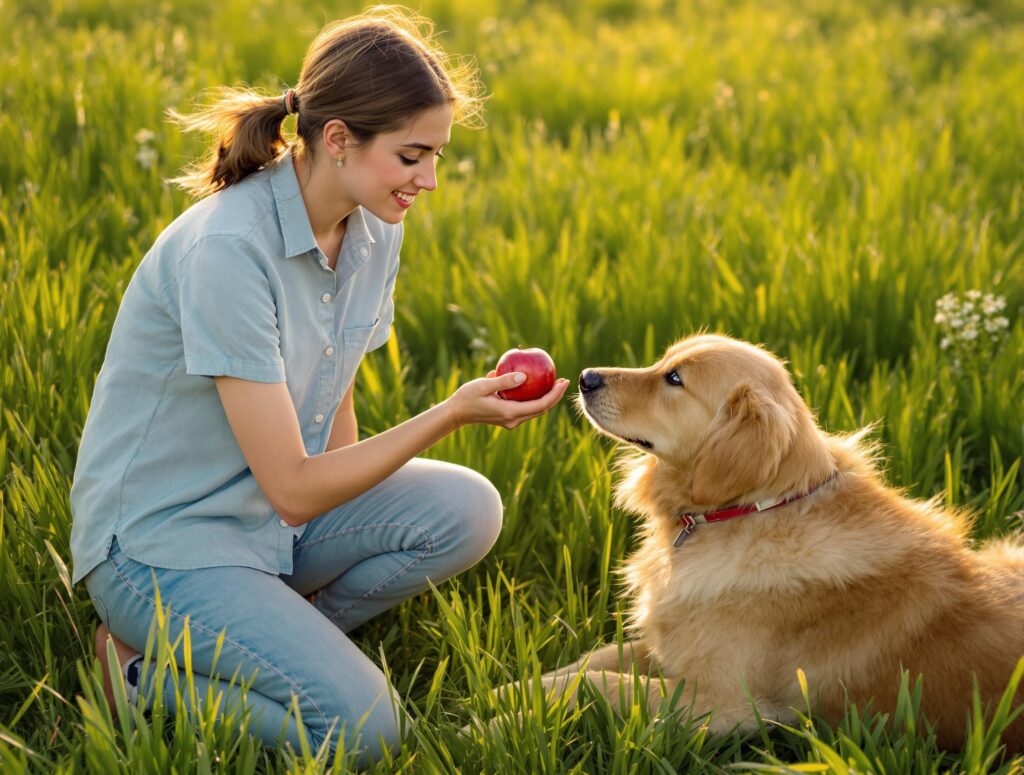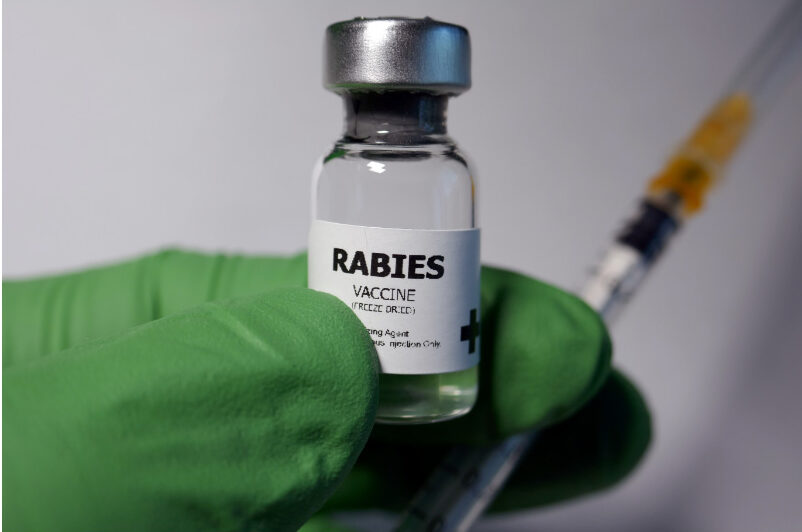Can Dogs Eat Apples? Everything You Need to Know

Key takeaways:
- Apples can be a healthy treat for dogs when served in moderation, offering vitamins A and C, fiber, and antioxidants that promote overall wellness.
- Safety is crucial: remove seeds and core to avoid choking hazards and potential cyanide toxicity from seeds.
- Introduce apples slowly to detect any allergic reactions or digestive issues, and keep treats to 10% of your dog’s daily food intake.
That familiar moment when you bite into a fresh, crisp apple and your dog gazes up with those hopeful eyes is hard to resist. It’s natural to want to share a healthy snack with your furry companion. The good news is that apples can be a wonderful treat for dogs when served with care.
PetHealthMD helps you understand how to offer fruits like apples safely, so you can make informed choices with your veterinarian. A whole apple contains about 19 grams of sugar, so moderation matters. With the right preparation and portion control, these crunchy bites can support both nutrition and dental health, making them a safe and enjoyable way to reward your dog.
Nutritional benefits of apples for dogs
The benefits of apples for dogs go beyond being a simple treat. They offer valuable nutrition that supports your furry friend’s overall well-being. These fresh fruits provide a satisfying crunch while delivering nutrients that help keep your dog healthy and active. When incorporated thoughtfully into your dog’s treat rotation, apples become a nourishing addition to their diet.
Here is what apples can provide:
- Immune system support: Apples are rich in vitamin A and vitamin C. These essential nutrients strengthen your dog’s immune system and act as powerful antioxidants, helping protect cells from damage.
- Healthy vision and skin: The vitamins in apples also support healthy vision and skin, contributing to your dog’s natural defenses and helping maintain their vibrant health as part of a balanced nutrition plan.
- Digestive health and weight management: Apples are naturally high in fiber, which promotes healthy digestion and helps with weight management. For dogs watching their weight, apple slices make a filling alternative to high-calorie commercial treats. The fiber also supports regular digestion, making apples a great option for dogs with sensitive stomachs or those needing extra digestive support. You can also explore additional digestive support remedies to help keep your dog’s tummy happy.
How to safely prepare apples for your dog
Want to share the crisp, sweet goodness of apples with your furry friend? Learning how to prepare apples for dogs is simple, and your pup will love this healthy treat. Follow these easy steps to make snack time both safe and enjoyable:
- Start with a good wash – run fresh apples under cool water, giving them a gentle scrub to remove any wax coating or residues. Organic apples are great, but when properly cleaned, any fresh apple will do.
- Remove all seeds, core, and stems before serving. Those little black seeds might look harmless, but they’re not good for your pup, so get rid of them completely.
- Cut the apple into bite-sized pieces.
Some tips for serving apples:
- Size matters: Aim for blueberry-sized pieces for small dogs (under 20 pounds). Medium to large dogs can enjoy pieces about the size of a standard dice. Adjust the size to match your dog’s chewing ability.
- Start slow: When offering apples for the first time, begin with just one or two small pieces. See how your dog responds. If they tolerate apples well, gradually include them as an occasional treat.
- Store wisely: If you prep apples ahead of time, keep the slices in a sealed container in your fridge. For the best crunch and flavor, use them within 24 hours.
- Mind the portions: Remember the 10% treat rule. Apple slices should make up no more than 10% of your dog’s daily calorie intake. For a 20-pound dog, that means about 2 to 3 apple slices per serving, offered a few times per week.
Potential allergic reactions and signs of intolerance
Dogs can have allergic reactions to apples, though it is not very common. Signs of an apple allergy usually appear on your dog’s skin or face. You might see:
- Redness or swelling around the mouth
- Persistent scratching
- Changes in breathing, like wheezing or coughing
If your dog has known food sensitivities, introduce new treats like apples with extra care. Should your dog experience signs of a food allergy, such as skin irritation or digestive upset, consult your veterinarian and consider using allergy relief solutions that can help manage symptoms and support comfort.
Stomach upset is different from an allergic reaction, but it is still important to watch for. Even without an allergy, some dogs get an upset tummy from apples. Start small with a tiny piece, about the size of a blueberry, and see how your dog responds. Common signs of stomach upset include:
- Loose stools
- Mild stomach discomfort
Keep an eye on your dog’s eating habits, energy levels, and potty patterns for the next day after trying a new food.
If your dog shows any concerning symptoms after eating apples, take action quickly. Watch for red flags like:
- Severe vomiting
- Ongoing diarrhea
- Excessive paw licking or face rubbing
- Trouble breathing
These symptoms mean it is time to call your vet right away. Always monitor your pup closely when introducing any new treat. Even a simple snack like apples can sometimes reveal sensitivities you didn’t know about before.
What other fruits besides apples can you safely serve to your dog?
Apples are not the only fruit you can share with your pup. Many fruits offer natural sweetness, hydration, and nutritional benefits. At the same time, some fruits should be avoided because they can be harmful to dogs. Here is a quick guide to help you choose dog-friendly fruits and know which ones to skip. Always check with your veterinarian if you are unsure about introducing a new fruit to your dog’s diet.
Fruits you can safely serve to dogs
These fruits can be a healthy treat for your dog when prepared properly and served in moderation:
- Blueberries – Rich in antioxidants and vitamins.
- Strawberries – High in vitamin C and fiber. Remove stems before serving.
- Bananas – A good source of fiber and potassium. Serve in small amounts due to the sugar content.
- Watermelon – Hydrating and low in calories. Be sure to remove seeds and rind.
- Cantaloupe – High in vitamins A and C. Serve without the rind.
- Pineapple – Provides vitamins and digestive enzymes. Remove skin and core.
- Pears – High in fiber and vitamins. Remove seeds and core.
Fruits dogs should avoid
Some fruits contain compounds that are toxic to dogs or can cause digestive issues:
- Grapes and raisins – Highly toxic and can even cause kidney failure.
- Cherries – Pits contain cyanide and can be a choking hazard.
- Avocados – Contain persin, which can be harmful to dogs.
- Citrus fruits (lemons, limes, grapefruits) – High acidity can upset your dog’s stomach.
- Persimmons – Seeds can cause intestinal blockage and stomach upset.
Frequently asked questions (FAQs) about dogs and apples

Why are the stems, cores, and seeds of apples dangerous to dogs?
While apple flesh is safe for dogs, the stem, core, and seeds should always be removed before serving. Apple seeds contain amygdalin, a compound that can release cyanide when digested, posing a serious risk if consumed in large quantities. The core is tough and can become a choking hazard or cause a digestive blockage. Similarly, the stem is not easily digestible and may also pose a choking risk. To keep your dog safe, always slice apples into bite-sized pieces and discard the stem, core, and seeds before offering this treat.
What should I do if my dog eats apple seeds?
Contact your veterinarian immediately if your dog consumes multiple seeds or shows symptoms like excessive drooling or breathing changes. For accidental consumption of one or two seeds, monitor your dog’s behavior over the next few hours.
Which apple varieties are best for my dog?
Gala apples provide a balanced sweetness and are easy to digest. Honeycrisp offers extra crunch and higher water content, making them refreshing treats. Red Delicious apples have a softer texture, ideal for older dogs or those with dental sensitivity.
How do apples benefit dog dental health?
The fibrous texture of apple flesh acts as a natural toothbrush, helping to scrub away plaque as your dog chews. The malic acid in apples may also assist in breaking down tartar buildup. While apples can be a helpful addition, maintaining your dog’s oral hygiene with regular dental supplies is still essential for long-term dental health.
Making apples part of your dog’s diet
Adding fresh apples to your dog’s snack options is a simple way to bring a little joy and extra nutrition to their daily routine. When served in small portions, these crunchy treats can support dental health and aid digestion. Like us, every dog has unique dietary needs, so it is always wise to check with your veterinarian before introducing new foods.
To better support your pet’s health, stock up on vet-recommended supplements, dental chews, and wellness products — PetMeds makes it easy to find everything you need to keep your four-legged friend happy and thriving.





